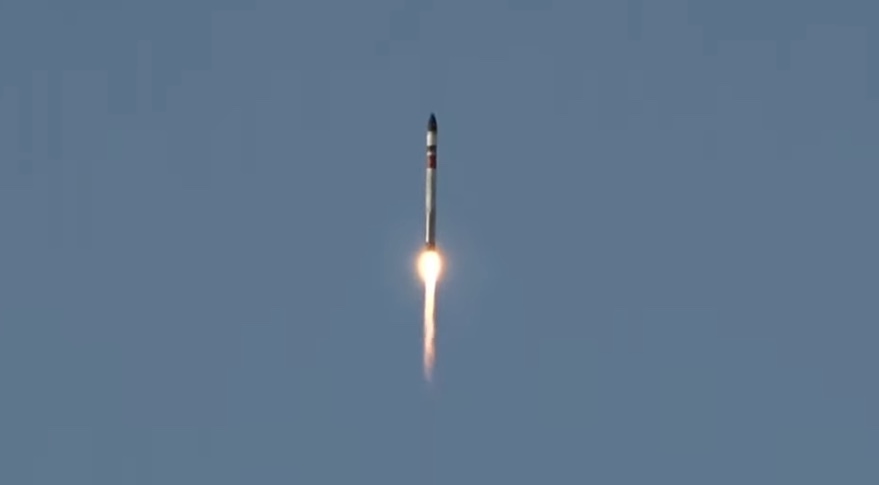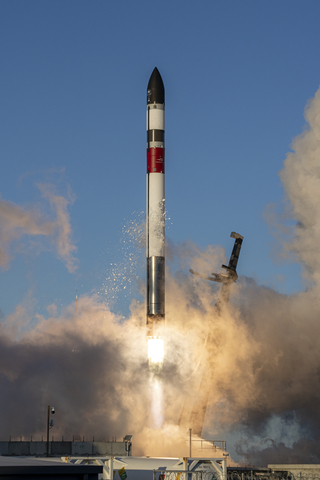6.11.2022

An Electron rocket lifts off Nov. 4 carrying the MATS satellite. While the rocket successfully deployed the satellite in orbit, the company was unable to perform a mid-air recovery of the booster. Credit: Rocket Lab webcast
WASHINGTON — Rocket Lab successfully launched a Swedish atmospheric science satellite on an Electron rocket Nov. 4, but a telemetry problem kept the company from attempting a mid-air recovery of the rocket’s booster.
The Electron rocket lifted off on the “Catch Me If You Can” mission at 1:27 p.m. Eastern from Rocket Lab’s Launch Complex 1 in New Zealand. The rocket’s primary payload, the MATS satellite for the Swedish National Space Agency, was deployed from the rocket’s kick stage about an hour after liftoff.
The company attempted to catch the booster, descending under parachute, with a helicopter equipped with a hook. That hook is designed to grapple the parachute, allowing recovery of the stage before it hits the water.
However, live video from the helicopter showed no sign of the booster, and Rocket Lab later said the mid-air catch had been called off. The company said it would instead recover the stage from the ocean, as on several previous launches.
Rocket Lab said in a series of tweets that launch controllers lost telemetry from the first stage as it reentered. “As standard procedure, we pull the helicopter from the recovery zone if this happens,” the company said. The stage safely splashed down and a ship was en route to pick it up.
“Rocket telemetry dropped out (it happens a bit during reentry) but we did not regain a solid link in time,” added Peter Beck, chief executive of Rocket Lab. “Without that link it’s just not safe to put the helicopter into the recovery zone, so we stood it off.”
This mission was the second attempt by Rocket Lab to perform a mid-air recovery of the booster, the last step before the company would attempt to reuse the booster. Mid-air recovery avoids having the stage be subjected to salt water, which can damage some components.
Rocket Lab made its first attempt at a mid-air recovery in May, and the hook was able to grapple the stage’s parachute. However, the helicopter released the stage moments later after noticing what the company called “different load characteristics than what we’ve experienced in testing.” The stage splashed down instead.
The recovery attempt overshadowed the successful launch of MATS, or Mesospheric Airglow/Aerosol Tomography and Spectroscopy. The satellite was built by OHB Sweden for the Swedish National Space Agency to study waves in the upper atmosphere and their influence on weather and climate.
The 54-kilogram satellite was originally slated to fly as a rideshare payload on a Soyuz launch, but the Swedish government abandoned those plans after Russia’s invasion of Ukraine. The spacecraft was designed to operate in a 585-kilometer dawn-dusk sun-synchronous orbit, one for which rideshare opportunities were limited and thus driving the need for a dedicated launch.
Quelle: SN
+++
Live coverage: Rocket Lab misses helicopter recovery attempt after successful liftoff from New Zealand
Live coverage of the countdown and launch of a Rocket Lab Electron rocket from Launch Complex 1B on Mahia Peninsula in New Zealand with the Swedish MATS atmospheric research satellite. Text updates will appear automatically below. Follow us on Twitter.
Rocket Lab’s live video webcast begins approximately 20 minutes prior to launch, and will be available on this page.
Rocket Lab’s Electron launcher placed a small Swedish atmospheric research satellite into an on-target polar orbit Friday, but an attempt to recover a booster stage with a helicopter was aborted after a brief telemetry loss from the rocket on descent.
Quelle: SN
+++
Rocket Lab Successfully Deploys 152nd Satellite
LONG BEACH, Calif.--(BUSINESS WIRE)-- Rocket Lab USA Inc, (Nasdaq: RKLB) (“Rocket Lab” or “the Company”), a leading launch and space systems company, has successfully launched its 32nd Electron mission to deploy its 152nd satellite to orbit, a science payload for the Swedish National Space Agency. The MATS satellite was deployed to its 585km circular orbit by Electron following lift-off at 17:27 UTC.

Lift-off of Rocket Lab's 32nd Electron mission, Catch Me If You Can (Photo: Business Wire)
“Congratulations to the teams at OHB Sweden and the Swedish National Space Agency on their mission,” says Rocket Lab founder and CEO Peter Beck. “It’s been a long journey for MATS, so I’m proud of the Rocket Lab team for doing their part to support this mission with a fast contract-to-orbit turnaround of just four months.”
The “Catch Me If You Can” mission also resulted in a successful ocean splashdown of the Electron rocket’s first stage. Rocket Lab had planned to attempt amid-air capture of Electron’s first stage with a helicopter if conditions allowed, however not all requirements were met to ensure a successful capture. Due to a brief telemetry loss with Electron’s first stage during its atmospheric re-entry, the helicopter was moved out of the capture zone per standard safety procedure. The Electron first stage completed a safe splashdown and Rocket Lab’s recovery vessel is now alongside the stage to bring it onboard and back to Rocket Lab’s production facility for inspection and analysis.
Catch Me If You Can was Rocket Lab’s ninth mission of the year, adding to an already-record year of successful orbital launches for the Company. Rocket Lab remains on track to launch its first Electron mission from Virginia before the end of the year, on a mission for HawkEye360 that is scheduled to launch in December.
“Bringing a rocket back from space is a challenging task and capturing it mid-air with a helicopter is as complex as it sounds,” said Rocket Lab founder and CEO, Peter Beck. “The chances for success are much smaller than that of failure because many complex factors that must perfectly align. We are proud to have successfully recovered our fifth rocket from the ocean now and we look forward to another mid-air capture attempt in future as we work toward making Electron a reusable rocket.”
Follow Rocket Lab’s social media channels for real time updates on upcoming missions, including the next recovery attempt.
Founded in 2006, Rocket Lab is an end-to-end space company with an established track record of mission success. We deliver reliable launch services, satellite manufacture, spacecraft components, and on-orbit management solutions that make it faster, easier and more affordable to access space. Headquartered in Long Beach, California, Rocket Lab designs and manufactures the Electron small orbital launch vehicle, the Photon satellite platform and the Company is developing the large Neutron launch vehicle for constellation deployment. Since its first orbital launch in January 2018, Rocket Lab’s Electron launch vehicle has become the second most frequently launched U.S. rocket annually and has delivered 152 satellites to orbit for private and public sector organizations, enabling operations in national security, scientific research, space debris mitigation, Earth observation, climate monitoring, and communications. Rocket Lab’s Photon spacecraft platform has been selected to support NASA missions to the Moon and Mars, as well as the first private commercial mission to Venus. Rocket Lab has three launch pads at two launch sites, including two launch pads at a private orbital launch site located in New Zealand and a second launch site in Virginia, USA which is expected to become operational in 2022.
Quelle:Rocket Lab


